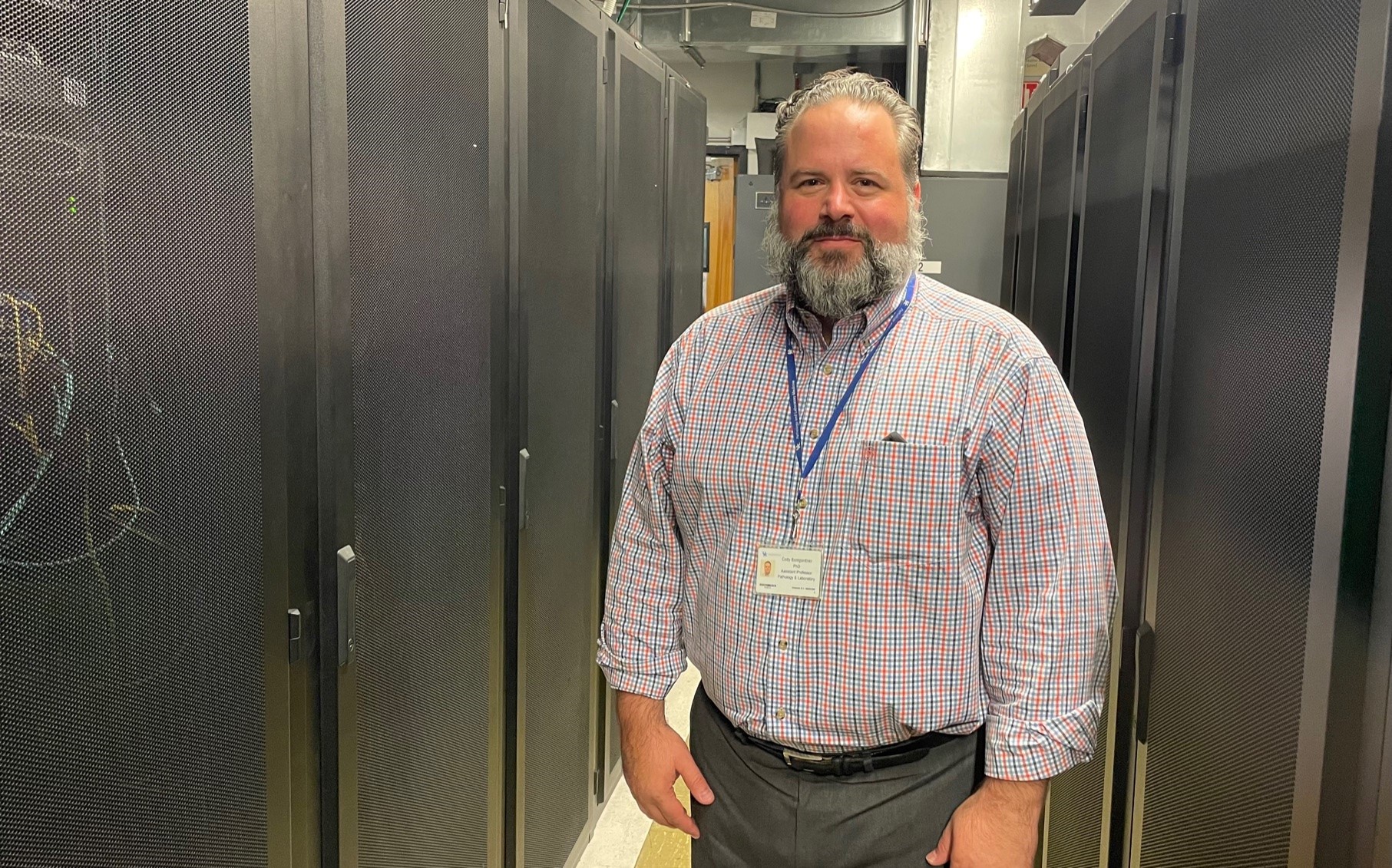UK Computer Scientist Brings Tech Expertise to New Alliance
The innate ability of Cody Bumgardner, PhD, to work with computer systems was evident in high school. Computers were being installed in one of his school’s first computer labs, and when workers unboxed the systems and left for lunch, he snuck into the lab and installed the hardware by the time they returned.
Dr. Bumgardner said school leadership was so impressed, they offered to pay for computer training if he helped out the school system. So at 15 years old, he took daily lessons and completed multiple certificate programs that made him employable as a technology specialist without traditional academic credentials. He has enjoyed a prosperous, fulfilling career in information technology ever since.
Now, he possesses a unique combination of skills, a PhD in computer science with a primary appointment in the College of Medicine Department of Pathology and Laboratory Medicine. He also serves as director of the division of pathology informatics.
It might not seem that his specialization in computers directly correlates with medicine, but Dr. Bumgardner’s role as a computer scientist is crucial in his department’s latest venture, AI in Medicine (AIM), a team within the College of Medicine’s Alliance Research Initiative.
In addition to building a medical artificial intelligence (AI) community at UK, the focus of AIM is to make data that is understood by humans understood by computers. This is done through curating raw data in discipline-specific systems matched with clinical measurements and outcomes maintained within electronic medical records.
Through the Alliance Research Initiative, AIM will receive vital support from the College of Medicine, UK HealthCare, and the Office of the UK Vice President for Research to advance its work.
Recent advances in AI technology have been fueled by the advancement of neural networks, a form of machine learning that is inspired by the human brain. The first step forward is to mimic human decision-making through trained observation. The eventual step is to allow AI to ask questions of itself and generate synthetic data opening the door to non-hypothesis-driven discovery. In medicine, this could mean quicker, potentially life-saving clinical diagnoses for patients.
“Extracting AI-actionable data from clinical workflows is the single most valuable activity we can undertake to move forward with AI in medicine,” Dr. Bumgardner said.
AIM will bring faculty from radiology, pathology, and computer science to build the infrastructure for handling the complexities of AI and biology.
“Pathology and radiology departments generate incredible amounts of information and data on patients from imaging to blood tests, biomarkers, and genetic data,” C. Darrell Jennings, MD, chair of pathology and laboratory medicine, said. “Our vision is to use the Alliance program to get computer scientists with an interest in biology, get pathologists and radiologists with interest in application of machine learning, and bring these people together.”
Hospital information technology has transformed throughout the years. Dr. Bumgardner compares his early years in the field to the Wild West. Departments were the town mayor, and technology-savvy faculty were outlaws – in a good way. The field worked in a decentralized approach, and innovation was quicker through direct work with department faculty.
The field now is focused on compliance and policy enforcement, adding challenges to the implementation of AI. One issue is more restrictive access to raw, high-resolution data, which is maintained outside of central electronic medical records.
Another larger challenge is finding ways to integrate into clinical workflows without disrupting IT-supported operational systems.
Now, “the stakes are much higher, technology and patient data is highly regulated, and there are no shortages of policies to prevent outlaw-type behavior, good and bad,” Dr. Bumgardner said.
AIM was recently approved by the College of Medicine. The team is ready to address these gaps in medical research through AI, potentially helping to position the college as a national leader in using this innovative technology for medical breakthroughs.
AIM Alliance Team Members:
- Therese Bocklage, MD, Professor – Department of Pathology and Laboratory Medicine
- Cody Bumgardner, PhD, Assistant Professor - Department of Pathology and Laboratory Medicine
- Jin Chen, PhD, Associate Professor – Department of Internal Medicine
- Quan Chen, PhD, Associate Professor – Department of Radiation Medicine
- Eric Durbin, DrPH, Associate Professor – Department of Internal Medicine
- Mark Ebbert, PhD, Assistant Professor – Sanders Brown Center on Aging
- Riham El-Khouli, MD, PhD, Assistant Professor – Department of Radiology
- David Fardo, PhD, Professor – College of Public Health
- Halemane Ganesh, MD, MBBS, Associate Professor – Department of Radiology
- Peter Hardy, PhD, Associate Professor – Department of Radiology
- Stephen Hobbs, MD, Associate Professor – Department of Radiology
- Nathan Jacobs, PhD, Professor – College Engineering
- Darrell Jennings, MD, Professor – Department of Pathology and Laboratory Medicine
- Jill Kolesar, PharmD, Professor – Department of Internal Medicine
- Elizabeth Oates, Chair and Professor – Department of Radiology
- Shadi Qasem, MD, Associate Professor – Department of Pathology and Laboratory Medicine
- Jeff Talbert, PhD, Professor – Department of Internal Medicine
- Xioqin Jennifer Wang, PhD, Assistant Professor – Department of Radiology
- Min Yu, MD, PhD, Assistant Professor – Department of Pathology and Laboratory Medicine
- Jie Zhang, PhD, Professor – Department of Radiology
